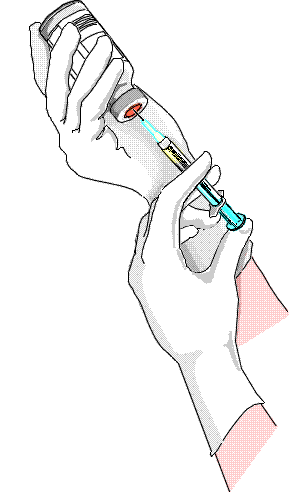
 when and where a reasonable chance exists of
your hands contacting chemicals or biologicals that have harmful or unknown
properties. At home you're "allowed" to get acetone or ethyl acetate (nail
polish removers), or the neighbor kid's blood, or Bo-Peep ammonia, or gasoline, or motor
oil, etc.... all over your hands (none of these recommended of course!). But
not at work. Gloves should NOT be worn in public corridors, nor when
touching doorknobs, light switches, telephones, radio dials.... or any shared-use item
which will be used by others who are not wearing gloves. If your work area has a
clear and completely enforced rule that all workers must wear gloves when touching these
latter items (excepting the corridor wearing), that rule would supersede the previous
statement. when and where a reasonable chance exists of
your hands contacting chemicals or biologicals that have harmful or unknown
properties. At home you're "allowed" to get acetone or ethyl acetate (nail
polish removers), or the neighbor kid's blood, or Bo-Peep ammonia, or gasoline, or motor
oil, etc.... all over your hands (none of these recommended of course!). But
not at work. Gloves should NOT be worn in public corridors, nor when
touching doorknobs, light switches, telephones, radio dials.... or any shared-use item
which will be used by others who are not wearing gloves. If your work area has a
clear and completely enforced rule that all workers must wear gloves when touching these
latter items (excepting the corridor wearing), that rule would supersede the previous
statement.
 It is necessary that the gloves you choose
prevent potentially harmful chemical
and biological materials from
contacting your skin. They must be chosen very carefully for
work with extremely toxic chemicals and dangerous pathogens. Chemical resistance
properties -- degradation and permeation test results
-- are tested using standard
ASTM methods for many (non-disposable) gloves, and
published resistance guides exist for chemical-protective materials in general.
Consult such a guide when choosing gloves, and do NOT
EVER use disposable gloves where known protection is needed or desired.
(Because they only provide an unknown level of protection.)
ORCBS
glove guide It is necessary that the gloves you choose
prevent potentially harmful chemical
and biological materials from
contacting your skin. They must be chosen very carefully for
work with extremely toxic chemicals and dangerous pathogens. Chemical resistance
properties -- degradation and permeation test results
-- are tested using standard
ASTM methods for many (non-disposable) gloves, and
published resistance guides exist for chemical-protective materials in general.
Consult such a guide when choosing gloves, and do NOT
EVER use disposable gloves where known protection is needed or desired.
(Because they only provide an unknown level of protection.)
ORCBS
glove guide
  don (put on) gloves and check for flaws, weak spots, breaches. An
extremely tight fit is undesirable because it stretches and weakens, and it impedes rapid
removal. Remove (doff) gloves before leaving your work area, and before touching
items that will be touched by others who are not wearing protection. Before removing
(unless very rapid removal is urgent), clean any gross chemical contamination from
gloves, by wiping or rinsing. For trivial and/or nontoxic contamination, or when
removal of contamination is not possible, gloves are to be removed in such a manner that
the external surface of either glove does not touch your unprotected skin; use your gloved
dominant hand to remove the other glove, then use that unprotected
non-dominant hand to
take hold of an uncontaminated part of the remaining glove (usually under glove cuff or
opening at wrist) and pull or push the dominant-hand glove over the fingers. don (put on) gloves and check for flaws, weak spots, breaches. An
extremely tight fit is undesirable because it stretches and weakens, and it impedes rapid
removal. Remove (doff) gloves before leaving your work area, and before touching
items that will be touched by others who are not wearing protection. Before removing
(unless very rapid removal is urgent), clean any gross chemical contamination from
gloves, by wiping or rinsing. For trivial and/or nontoxic contamination, or when
removal of contamination is not possible, gloves are to be removed in such a manner that
the external surface of either glove does not touch your unprotected skin; use your gloved
dominant hand to remove the other glove, then use that unprotected
non-dominant hand to
take hold of an uncontaminated part of the remaining glove (usually under glove cuff or
opening at wrist) and pull or push the dominant-hand glove over the fingers.
 Not all gloves resist all chemicals, and NO gloves resist ANY chemicals
indefinitely. Some types of disposable gloves are being found to be less effective
at stopping viruses (latex and non-latex rubber are currently deemed best for pathogens).
Disposable gloves offer extremely marginal protection from chemicals in
most cases and should be removed immediately on contamination. Select gloves
carefully
using data generated by
standard tests. Not all gloves resist all chemicals, and NO gloves resist ANY chemicals
indefinitely. Some types of disposable gloves are being found to be less effective
at stopping viruses (latex and non-latex rubber are currently deemed best for pathogens).
Disposable gloves offer extremely marginal protection from chemicals in
most cases and should be removed immediately on contamination. Select gloves
carefully
using data generated by
standard tests.
 Disposable
gloves should never be re-used (put on again after Disposable
gloves should never be re-used (put on again after removing). All gloves must be inspected before every use, for possible holes, tears,
weak areas. Reusable gloves should be cleaned after each use, and stored so that
they may dry inside and out. If your hands sweat, it is prudent to wear a light
disposable under reusable gloves to prevent their inside from becoming damp. Any
gloves from which hazardous chemical contamination cannot be removed must be collected in
a hazardous waste and disposed of through REM. Gloves contaminated with biologicals
should be handled as biohaz or look-alike waste, depending on the contamination. The
useful life of reusable gloves will vary drastically depending on the frequency of use,
duration of exposure to chemicals, the identity of chemicals to which they are exposed,
and the conditions of cleaning and storage.
removing). All gloves must be inspected before every use, for possible holes, tears,
weak areas. Reusable gloves should be cleaned after each use, and stored so that
they may dry inside and out. If your hands sweat, it is prudent to wear a light
disposable under reusable gloves to prevent their inside from becoming damp. Any
gloves from which hazardous chemical contamination cannot be removed must be collected in
a hazardous waste and disposed of through REM. Gloves contaminated with biologicals
should be handled as biohaz or look-alike waste, depending on the contamination. The
useful life of reusable gloves will vary drastically depending on the frequency of use,
duration of exposure to chemicals, the identity of chemicals to which they are exposed,
and the conditions of cleaning and storage. |


 removing). All gloves must be inspected before every use, for possible holes, tears,
weak areas. Reusable gloves should be cleaned after each use, and stored so that
they may dry inside and out. If your hands sweat, it is prudent to wear a light
disposable under reusable gloves to prevent their inside from becoming damp. Any
gloves from which hazardous chemical contamination cannot be removed must be collected in
a hazardous waste and disposed of through REM. Gloves contaminated with biologicals
should be handled as biohaz or look-alike waste, depending on the contamination. The
useful life of reusable gloves will vary drastically depending on the frequency of use,
duration of exposure to chemicals, the identity of chemicals to which they are exposed,
and the conditions of cleaning and storage.
removing). All gloves must be inspected before every use, for possible holes, tears,
weak areas. Reusable gloves should be cleaned after each use, and stored so that
they may dry inside and out. If your hands sweat, it is prudent to wear a light
disposable under reusable gloves to prevent their inside from becoming damp. Any
gloves from which hazardous chemical contamination cannot be removed must be collected in
a hazardous waste and disposed of through REM. Gloves contaminated with biologicals
should be handled as biohaz or look-alike waste, depending on the contamination. The
useful life of reusable gloves will vary drastically depending on the frequency of use,
duration of exposure to chemicals, the identity of chemicals to which they are exposed,
and the conditions of cleaning and storage.